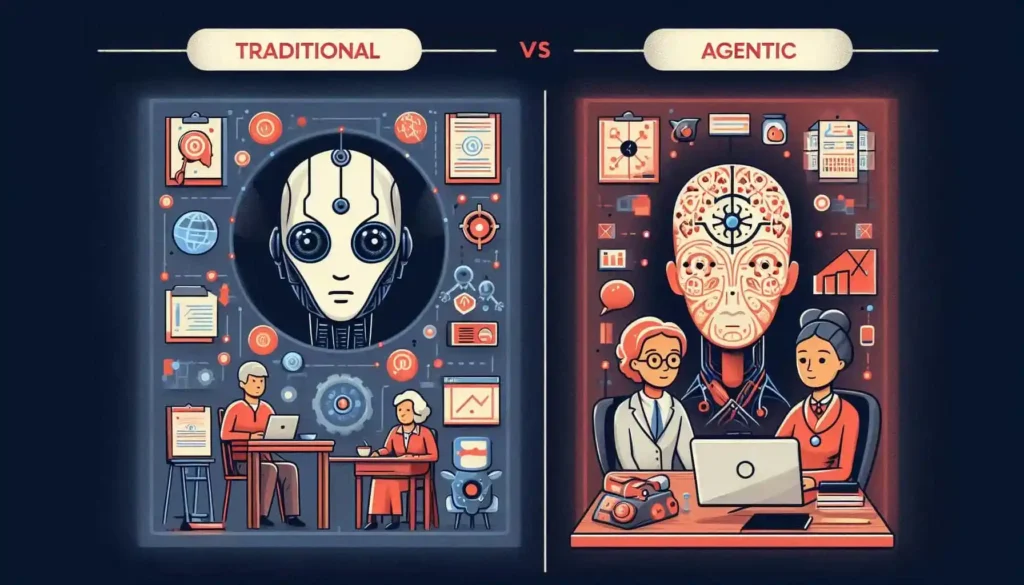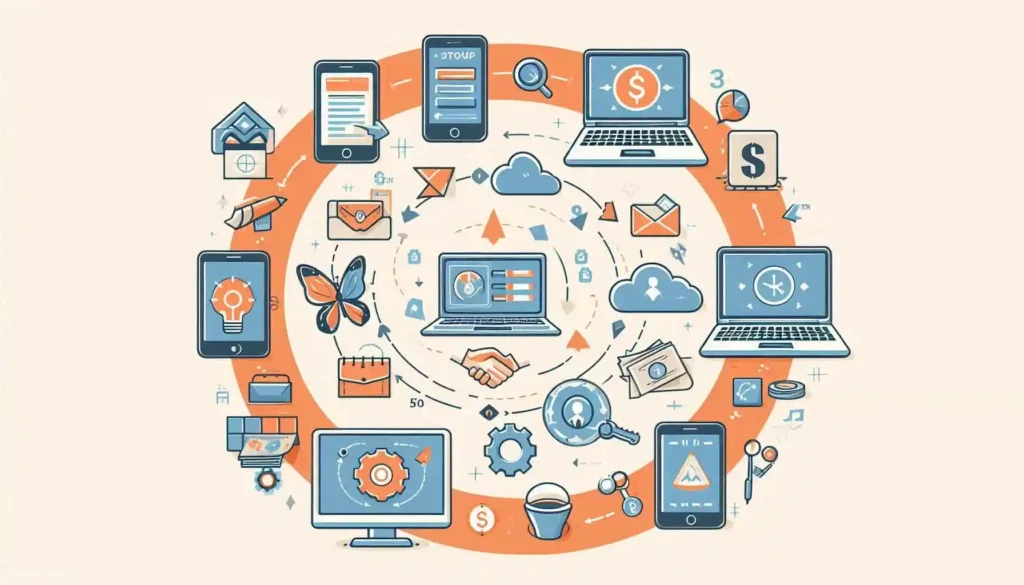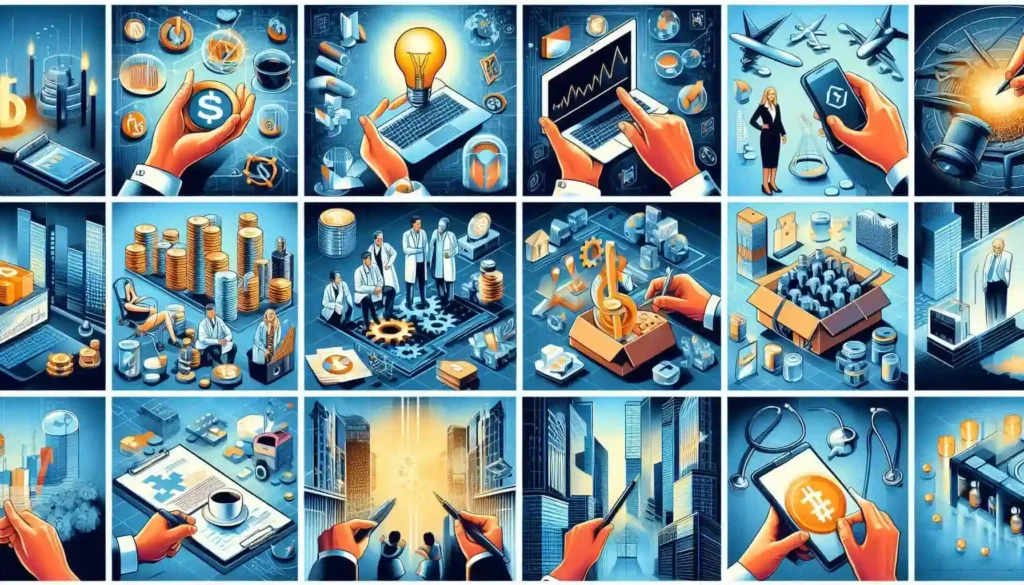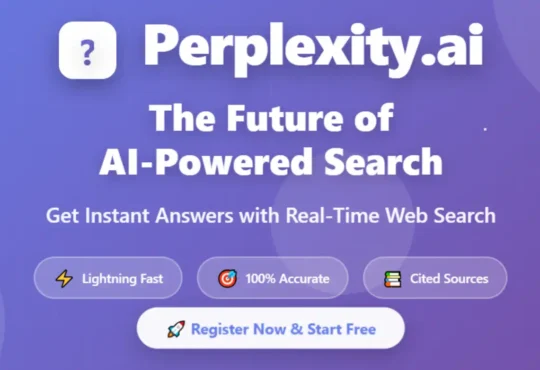Artificial intelligence has evolved dramatically over the past few years. We’ve moved from simple chatbots to sophisticated language models, and now we’re entering the era of Agentic AI—a transformative technology that’s reshaping how businesses operate.
Unlike traditional AI systems that require constant human prompting, agentic AI operates autonomously, planning and executing complex tasks with minimal human intervention. In 2025, this technology is experiencing explosive growth with a 127% year-over-year increase and is projected to reach $78.2 billion by 2030.
This comprehensive guide will explore what agentic AI is, how it works, real-world applications, and why your organization should care.
What is Agentic AI? Definition and Overview
Agentic AI refers to autonomous artificial intelligence systems that can perceive their environment, plan actions, execute tasks, and adapt their strategies based on outcomes—all without constant human supervision.
Key characteristics of agentic AI include:
- Autonomous Decision Making: Makes intelligent decisions without requiring human input for every step
- Multi-Step Problem Solving: Breaks complex tasks into manageable subtasks and solves them systematically
- Real-Time Adaptation: Adjusts strategies based on changing conditions and feedback
- Goal-Oriented Behavior: Works toward specific objectives set by humans
- Minimal Oversight: Operates independently while maintaining transparency and controllability

How Agentic AI Differs from Traditional AI
Traditional AI systems are reactive—they respond to inputs with outputs. You ask a question, you get an answer. Agentic AI, however, is proactive and autonomous.
Agentic AI can:
- Identify problems without being explicitly told
- Create action plans independently
- Execute multi-step processes
- Monitor outcomes and adjust course as needed
- Operate for extended periods with minimal human intervention
Why Agentic AI Matters in 2025
The enterprise adoption of agentic AI in 2025 marks a pivotal moment in business automation:
- 80% of major companies are already deploying agents
- 127% year-over-year growth in implementation
- Average ROI exceeds 100% within 18-24 months
- $2.6-4.4 trillion potential annual GDP contribution by 2030
How Does Agentic AI Work? The 4-Step Framework
Agentic AI systems operate through a cyclical four-step process that repeats continuously to achieve objectives and improve performance.

Step 1: Assess – Environment Evaluation
The AI agent evaluates the current situation, gathers relevant data, and understands the task requirements. This is the perception phase where the system “observes” its environment.
During assessment, the agent:
- Analyzes available data and context
- Identifies constraints and resources
- Defines success metrics
- Determines required information
Step 2: Plan – Strategic Action Design
Based on the assessment, the agent creates an action plan. It breaks complex objectives into smaller, manageable steps and determines the most effective approach to achieve goals.
Planning involves:
- Breaking down complex objectives into subtasks
- Prioritizing tasks based on importance and dependencies
- Allocating resources efficiently
- Identifying potential obstacles and risks
- Creating contingency strategies
Step 3: Act – Autonomous Execution
The agent executes the planned actions autonomously. It interacts with systems, APIs, databases, and humans as needed to move toward the objective.
Action execution includes:
- Performing automated tasks efficiently
- Integrating with business systems seamlessly
- Collecting real-time data for monitoring
- Maintaining workflow continuity
- Coordinating with humans when necessary
Step 4: Adapt – Continuous Learning and Adjustment
The agent monitors outcomes in real-time, learns from results, and adapts its strategy if conditions change or if the initial approach isn’t working as expected.
Adaptation mechanisms include:
- Real-time performance monitoring and analysis
- Outcome evaluation against metrics
- Strategy refinement based on results
- Continuous improvement processes
- Learning from successes and failures
Core Capabilities of Agentic AI Systems
Modern agentic AI systems possess several powerful capabilities that set them apart from traditional AI solutions.
Autonomous Decision Making
Agentic AI systems can make informed decisions based on data, context, and predefined objectives without requiring human approval for each decision.
Examples:
- Healthcare: Recommending treatment options based on patient data
- Finance: Approving transactions within risk parameters
- Supply Chain: Rerouting shipments based on real-time conditions
Complex Problem Decomposition
Large, complex problems are automatically broken down into smaller, solvable components. The AI orchestrates the solution across multiple steps and systems.
Benefits:
- Reduces solution time by 40-60%
- Improves accuracy through a systematic approach
- Enables parallel processing of subtasks
- Maintains complex workflow coordination
Real-Time Environment Adaptation
These systems continuously monitor their environment and adjust their strategies in real-time. If a plan isn’t working, the agent pivots without human instruction.
Key Advantages:
- Responds instantly to changing conditions
- Minimizes losses and maximizes opportunities
- Maintains operational continuity
- Reduces need for human intervention
Seamless System Integration
Agentic AI can integrate with existing enterprise systems, APIs, databases, and workflows to orchestrate end-to-end business processes.
Integration Capabilities:
- API connectivity with third-party services
- Database integration and management
- Legacy system compatibility
- Cloud and on-premise deployment options
- Third-party tool integration
Real-World Applications of Agentic AI in 2025

Healthcare: Autonomous Diagnostic Support
Agentic AI systems are transforming healthcare by providing intelligent, autonomous support across multiple areas.
Key Applications:
- Autonomous diagnostic recommendations
- Patient monitoring and predictive alerts
- Treatment plan optimization
- Administrative task automation
- Drug interaction and contraindication checking
- Medical records organization and analysis
Results Reported:
- 40% reduction in diagnostic time
- Improved patient outcomes through continuous monitoring
- 25% decrease in medical errors
- 50% faster administrative processing
- 24/7 patient monitoring capabilities
Supply Chain and Logistics: Predictive Autonomy
Unlike traditional supply chain tools that react to problems, agentic AI proactively manages entire supply chains.
Autonomous Functions:
- Real-time inventory level monitoring
- Demand pattern prediction
- Shipping delay anticipation
- Automatic shipment rerouting
- Warehouse optimization
- Vendor coordination and management
- Cost minimization strategies
Business Impact:
- 60% reduction in supply chain delays
- 15-20% cost savings through optimization
- 30% improvement in inventory accuracy
- 98% on-time delivery rates
- Reduced stockouts and excess inventory
Legal Services: Autonomous Contract Analysis
Law firms are using agentic AI to revolutionize how they handle legal documents and compliance.
Autonomous Legal Tasks:
- Contract review and analysis
- Legal risk identification
- Modification suggestions
- Regulatory compliance verification
- Key term extraction and organization
- Obligation tracking and reminders
Results from Major Law Firms:
- 70% reduction in document review time
- 85% improvement in compliance accuracy
- Significant cost savings on legal labor
- Faster contract turnaround times
- Reduced risk of missed obligations
Financial Services: Intelligent Risk Management
Financial institutions deploy agentic AI for sophisticated, autonomous risk management and fraud detection.
Key Financial Applications:
- Risk assessment and continuous monitoring
- Fraud detection in real-time
- Portfolio management and optimization
- Compliance monitoring across jurisdictions
- Trade execution and optimization
- Customer creditworthiness analysis
Results Reported:
- 90% improvement in fraud detection accuracy
- Significant reduction in compliance violations
- Faster transaction processing
- Better portfolio performance through optimization
- Reduced operational risk
Market Growth and Economic Impact
Agentic AI Market Statistics

- $78.2 Billion – Projected market size by 2030
- 127% YoY Growth – Rate of adoption in 2025
- 100%+ ROI – Average return on investment for enterprises
- 80% of Companies – Already deploying agentic AI in some capacity
- 50%+ of AI Budgets – Allocated specifically to agentic AI initiatives
Global Economic Impact of Agentic AI
According to PwC’s Global Research 2025, agentic AI could contribute $2.6-4.4 trillion annually to global GDP by 2030, representing a potential boost of 3-5% to world economic output.
This isn’t just hype—enterprises are seeing tangible, measurable results:
- Enterprise ROI: 100%+ average within 18-24 months
- Productivity Gains: 30-50% improvement in process efficiency
- Cost Reduction: 15-40% decrease in operational costs
- Faster Time-to-Market: 25-35% acceleration in product launches
Challenges and Important Considerations
Governance and Accountability
Autonomous systems require robust governance frameworks, audit trails, and clear accountability mechanisms. Who is responsible if an AI agent makes a costly mistake? Organizations must establish clear policies and oversight procedures.
Security and Data Protection
Protecting sensitive data while maintaining system autonomy requires advanced security architectures, encryption, and compliance frameworks. Data breaches could expose not just information but operational vulnerabilities.
Regulatory Compliance
Different jurisdictions have varying requirements for autonomous systems. Organizations must navigate complex regulatory landscapes and ensure their agentic AI implementations comply with local, regional, and international laws.
Workforce Adaptation and Training
Employees need training and reskilling to effectively collaborate with autonomous AI systems. This requires investment in employee development, change management, and organizational culture shifts.
Ethical Considerations
Organizations must ensure their agentic AI systems behave ethically, don’t perpetuate bias, and align with corporate values and social responsibility commitments.
How to Implement Agentic AI in Your Organization
Step 1: Identify High-Impact Use Cases
Start by identifying processes that are:
- Repetitive and rule-based
- Time-consuming and resource-intensive
- High-cost operations
- Prone to human error
- Benefit from 24/7 operation
Step 2: Assess Your Infrastructure
Evaluate:
- Current data quality and availability
- System integration capabilities
- Security and compliance requirements
- Team expertise and training needs
- Budget and resource allocation
Step 3: Choose the Right Platform or Partner
Select an agentic AI platform that:
- Integrates with your existing systems
- Meets your security and compliance requirements
- Offers adequate support and training
- Provides customization capabilities
- Has proven track record in your industry
Step 4: Start Small with Pilot Projects
Begin with low-risk, high-reward pilot projects to:
- Prove ROI and business value
- Build internal expertise and confidence
- Identify implementation challenges early
- Gain stakeholder buy-in and support
- Learn and iterate before full rollout
Step 5: Scale Gradually
After successful pilots, expand gradually to:
- Additional departments and teams
- More complex processes and workflows
- Enterprise-wide deployment
- New use cases and industries
Future Outlook: What’s Next for Agentic AI?

The trajectory for agentic AI is clear and exciting:
- 2025-2026: Mainstream enterprise adoption with focus on efficiency and cost reduction
- 2026-2028: Integration with emerging technologies like quantum computing and edge AI
- 2028-2030: Market matures with specialized agents for industry-specific applications
- Beyond 2030: Potential integration with AGI frameworks and advanced autonomous systems
Emerging Technology Trends
AI-Quantum Convergence: Agentic AI combined with quantum computing will unlock entirely new capabilities in optimization and complex problem-solving.
Domain-Specific Agents: Specialized agents for healthcare, finance, legal, manufacturing, and other industries will become increasingly sophisticated and tailored.
Multi-Agent Systems: Multiple agentic AI systems will work together, coordinating efforts to solve even more complex organizational challenges.
Regulatory Maturity: As regulations evolve, frameworks for autonomous AI governance will become standardized, reducing implementation friction and increasing adoption.
Conclusion: Why Agentic AI Matters Now
Agentic AI isn’t coming in the future—it’s here now, transforming how organizations operate across every industry. With 127% year-over-year growth, $78.2 billion market projections by 2030, and average ROI exceeding 100%, organizations that delay adoption risk falling behind competitors.
Key Takeaways:
- Agentic AI operates autonomously, requiring minimal human intervention for routine tasks
- Real-world applications are already delivering measurable results across healthcare, finance, supply chain, legal, and customer service
- The ROI is compelling, with enterprises reporting 100%+ returns within 18-24 months
- Implementation is achievable, starting with pilot projects and scaling gradually
- The competitive advantage is significant for early adopters
Whether you’re in a startup or a Fortune 500 company, whether you operate in healthcare, finance, manufacturing, or any other sector, agentic AI offers compelling opportunities to increase efficiency, reduce costs, and unlock new competitive advantages.
The question isn’t whether to implement agentic AI—it’s when and how to get started.
Frequently Asked Questions About Agentic AI
Is Agentic AI the same as Artificial General Intelligence (AGI)?
No. Agentic AI is autonomous within specific domains and tasks. AGI would be general-purpose intelligence comparable to human intelligence. Agentic AI is narrow AI that operates autonomously within defined parameters.
How much does Agentic AI implementation cost?
Costs vary widely based on complexity, customization, and scale. Pilot projects can start at $50K-$250K, while enterprise-wide implementations range from $1-10M+. Most organizations see ROI within 18-24 months.
What skills do we need to implement Agentic AI?
You need data engineers, AI/ML specialists, domain experts, and change management professionals. Training existing staff is also essential for successful adoption.
How does Agentic AI handle security and privacy?
Security depends on implementation. Reputable platforms include encryption, access controls, audit trails, and compliance certifications (SOC 2, ISO 27001, HIPAA, GDPR).
Can Agentic AI replace humans?
Agentic AI augments human capabilities rather than replacing them. It handles routine, repetitive tasks while humans focus on strategy, creativity, and complex decision-making.
Thank you for visiting our website, TechsBucket. If you liked the article, then share it with others.


